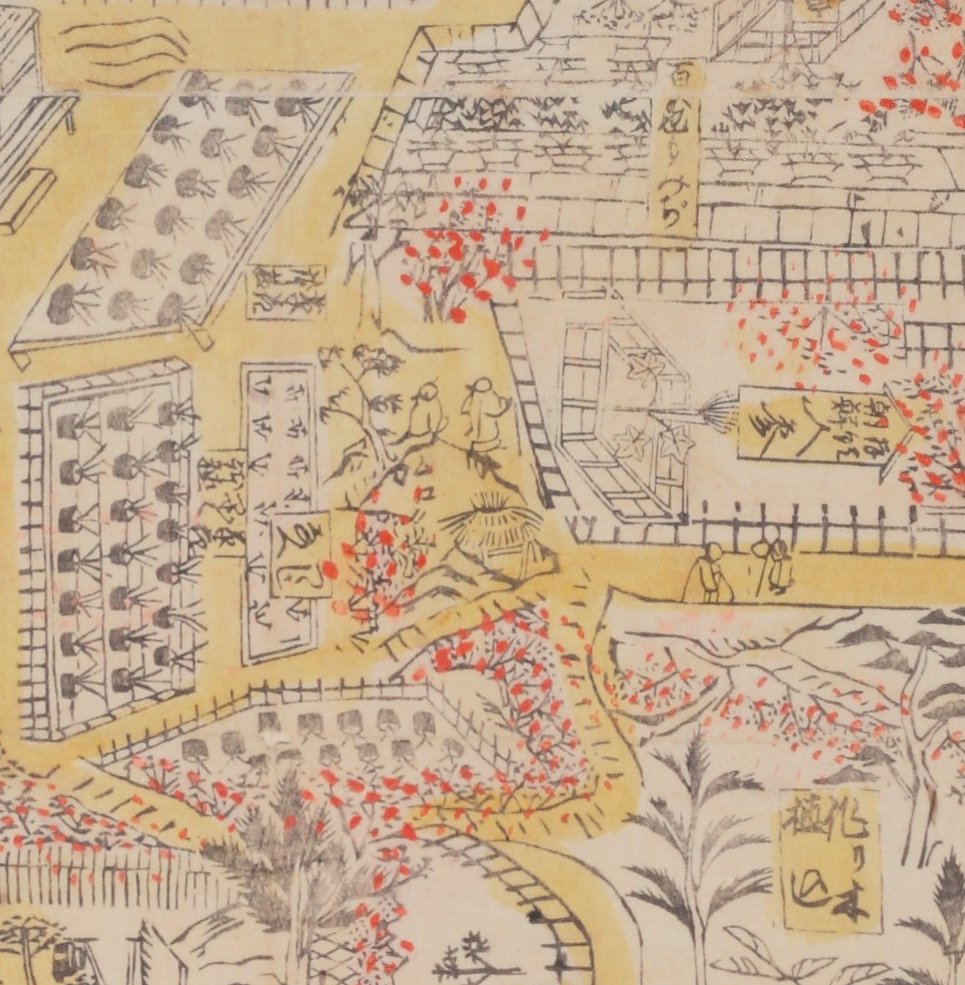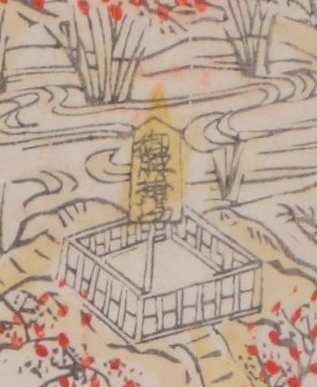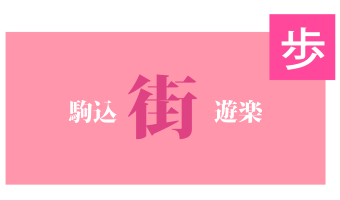| A. 江戸 駒込・染井遊楽 / A tour of Somei, Komagome in the Edo period | ||
| ソメイヨシノ発祥の地といわれる駒込。江戸時代は、どのような街だったのでしょうか。当時の様子をお楽しみください。 | ||
|
Komagome is said to be the birthplace of the Somei Yoshino (Yoshino cherry). But what was this area like in the Edo period? Enjoy a look at Komagome in the past. |
||
|
|
||
|
|
||
|
|
||
| 周辺の切絵図を見る | ||
| 大名屋敷の庭の様子 / A look at the garden of a daimyou yashiki (residence of a feudal lord). | |
|---|---|

「藤堂和泉守殿染井下屋敷図」 |
藤堂家下屋敷である。明暦の大火(世に言う振袖火事)によりこの地に居を構える。藤堂家は、伊勢国(現三重県)に32万石余りの所領を持つ外様大名で江戸城の設計をしたといわれる藤堂高虎を藩祖とする。染井の屋敷は下屋敷・抱屋敷を併せ6万8千坪と広大で、約2,000人の家臣が居住し、染井屋敷と呼ばれていた。 では、実際に大名屋敷の敷地の中の様子はどうだったのだろうか?
江戸時代の駒込巣鴨地域にはいくつかの大名屋敷があったが、染井通りの南側部分に面していた(抱屋敷も含む)のが、伊勢国藤堂(津)藩江戸屋敷(染井屋敷)である。第2代藩主藤堂高次の治世期にあたる万治元年(1658)に成立した。
駒込・巣鴨の園芸を代表する伊藤伊兵衛は、かつてこの屋敷に出入りする下男的な存在であり、藤堂家で不要になった花木を自分の庭に運んできて培養し、霧島つつじ・椿・楓など数多くの種類を保有するようになったといわれている。この屋敷図は下屋敷内の様子を描いたものとして貴重である。 文献※によると表居間、奥部屋、茶屋、(能)舞台、米蔵、長屋といった建物や、辻番所、所塀、もがり塀などの区画施設の名が見られ、第二代藩主高次が動物好きであったことから鳥長屋が八棟あった。 このほか、一時期ヤマアラシ、鶴、将軍家から下賜された白熊も飼っていたといわれている。屋敷内には大型の塀や堀が張り巡らされ霧島ツツジのほか、紅葉や松、熊笹などが植えられており、樹木はいずれも大木だったようである。 作庭は元禄期頃で、侘びは少なく「武気」「勇気」のある庭であったと評している。 また、石造物が数多くあり、灯籠のほか、不動明王や具利伽羅龍、獅子に乗った観音のような像等やや変わった珍しいものであったと伝えられている。 (※「江戸周辺の大名屋敷 小川祐司」)
A shimo yashiki (suburban residence) owned by the Toudou clan. The clan took up residence here as a result of the Great Fire of Meireki (also known as the Furisode Fire). The Toudou clan was a tozama daimyou ("outside" feudal lord) family that owned a domain assessed at approximately 320,000 koku (1.6 million bushels) of rice in Ise no kuni (Ise Province, located in modern day Mie Prefecture). Clan founder Toudou Takatora is said to have designed Edo Castle. The Somei yashiki (the Toudou clan residence at Somei), was a vast property of 68,000 tsubo (approx. 224,793 m2), including the suburban residence and the kakae yashiki (farmland residence), and was home to around 2,000 vassals.
So what did a feudal lord's residence actually look like? There were many residences of feudal lords in the Komagome-Sugamo area in the Edo period. The Ise Province Toudou (Tsu) han (domain) Edo residence (Somei residence) faced the southern side of Somei Street (this included the farmland residence). It was established in Manji period 1 (1658), during the rule of the second lord of the Tsu Domain, Toudou Takatsugu. Itou Ihei, the face of Komagome and Sugamo horticulture, was a kind of manservant who frequented this residence. It is said that he took flowers and trees that the Toudou clan no longer needed to his personal garden and cultivated them there, eventually amassing a large variety of plants, including Kirishima tsutsuji (azaleas), camellias, and maples. This picture of the residence is valued because it shows the interior appearance of the suburban residence grounds. In reference materials*, the names of buildings like the omoteima (parlors), okubeya (inner rooms), chaya (teahouses), nou butai (stages for Nou performances), komegura (rice granaries), and nagaya (terrace houses), as well as partitions such as tsujibansho (guard stations), tokoro hei (details unknown), and mogaribei (bamboo fences). It even seems that Takatsugu, an animal lover, had eight torinagaya (aviaries) built on the grounds. He is also said to have at some point owned a porcupine, a crane, and even a polar bear granted to him by the shogunate family. Large walls and moats stretched across the grounds, and there were many large trees and shrubs, including azaleas, maples, pines, and kumazasa (dwarf bamboo). The gardens were built in the Genroku period (c. 1688 - 1704), and are noted as being bold and militant, lacking in simplicity. There are also reports of many stone figures, including tourou (lanterns), Fudou Myouou (statues of the Buddhist deity Acala), Kurikararyuu (statues of a dragon coiled around a sword), Kannon (statues of the Buddhist deity Guanyin) riding a lion, and other unusual figures. (* "Edo Shuuhen no Daimyou Yashiki" by Yuuji Ogawa) |
| 植木屋の風景 / The Landscape of Gardening. | |||||||||
|---|---|---|---|---|---|---|---|---|---|
|
もともと染井に住んでいた農民は、明暦の大火後に居を構えた藤堂家の下屋敷に、庭の管理の為、出入りするようになったが、彼らはそこで不要になった霧島つつじ・椿・楓等数多くの植物を自分の庭に運んできて栽培し植木屋になった。 彼らの努力のかいもあって、江戸時代後期には江戸を代表する園芸センターとして知られるようになり、イギリスの植物学者であるロバートフォーチュンは「わたしは世界のどこへ行ってもこんなに大規模に、売り物の植物を栽培しているのを見たことがない」と染井村のことを自身の著書に記している。 それでは、染井村に住む、植木屋たちはいったいどのような活動をしていたのであろうか? 次の2種類の資料によりその一部をかいまみることができる。
Farmers who already lived in Somei when the Toudou clan took up residence there following the Great Fire of Meireki began frequenting the suburban residence to maintain its gardens. Plants that were no longer needed in the residence gardens were taken home to the personal gardens of the farmers, who became gardeners in their own right by cultivating azaleas, camellias, maples, and other plants they had received.
Thanks to their efforts, by the end of the Edo period, Somei had become the main center of horticulture in the city of Edo. British botanist Robert Fortune even wrote about the village in one of his books, stating "I have never seen, in any part of the world, such a large number of plants cultivated for sale." So what exactly did the gardeners of Somei village do? We can catch a glimpse of their activities through the following two types of documents. |
|||||||||
|
|||||||||
| 伊藤伊兵衛の庭を散歩する / Take a walk through the garden of Itou Ihei. | |
|---|---|

「武江染井翻紅軒霧島之図」 [Take a walk through the garden] |
最後に江戸第一の植木屋といわれた伊藤伊兵衛の庭を散策してみよう。 元文期(1736~1741)末頃の伊藤伊兵衛の庭園を当時の人気浮世絵画家である近藤清春が描いたものである。 キリシマツツジが見ごろとなる4月下旬頃から花見見物客への宣伝・周知用として板行されたもので、今で言う観光案内パンフレットの類に該当する。 「新編武蔵風土記稿」の記述によると、もともと薩摩国を発祥とするキリシマツツジの1本を正保期(1644~47)に大坂で取木の方法で増やし、5本を京都へ送った。美しい花だったのでそれぞれの木に、富士山・麟角・面向・無三・唐松という名前をつけた。これらのうち、富士山と麟角の2本については特に勝れていたので朝廷の庭に植え、残る3本は明暦2年に染井へ送られた。それから接ぎ木などを行い苗木を増やして江戸をはじめ各地へ広めた。その3本は毎年、春になるときれいに開花すると伝えられている。 その様子がここに見事に表されており、この案内を片手に花見客は散策をたのしんでいたのであろう。 それでは、入口から順に江戸時代さながら、伊藤伊兵衛庭を探索してみよう。
At the end , take a stroll through the garden of Itou Ihei, known as the top gardener in Edo.
This picture shows an image of Itou Ihei's garden at the end of the Genbun period (c. 1736 - 1741) as painted by Kondou Kiyoharu, a famous artist of ukiyoe (Edo period prints) at that time. It was printed to advertise the azaleas of the area to bring visitors there in late April when the flowers were in full bloom, and can be thought of as similar to the tourist pamphlets of today. According to the "Shinpen Musashi Fudo Kikou" (a typography of Musashi Province), a single Kirishima azalea plant was brought from its birthplace in Satsuma no kuni (Satsuma Province, in modern day Kagoshima and Miyazaki Prefectures) to Oosaka in the Shouhou period (1644 - 1647) and propagated there through layering, after which five plants were sent to Kyouto. These beautiful shrubs were given the names Fujisan, Rinkaku, Menkou, Musan, and Karamatsu. Of these, Fujisan and Rinkaku were particularly superb, and were planted in the gardens of the imperial court, while the remaining three plants were sent to Somei in Meireki year 2. They went on to be grafted to form new saplings, which were then spread throughout Edo and the rest of Japan. Lovely flowers were said to bloom on these shrubs every spring. This image is reproduced here splendidly, so visitors must have had this guide in hand as they strolled through the garden to view the flowers. Now let us imagine we are in the Edo period and explore the garden of Itou Ihei starting at the entrance. |
| A | |
|---|---|

[絵図の部分を見る / View the picture] |
武家の者と思われる人物が、後ろ手を組んで「つつじいけかき」「きりしまうへこみ」の方向を眺めている。従者らしき人物も数人確認できる。
A person thought to be a samurai is holding his hands behind his back and gazing at the "tsutsuji ikekaki (azalea hedges)" and "Kirishima uekomi (Kirishima shrubbery)". Several people who appear to be attendants can also be seen.
|
| B | |
|---|---|

[絵図の部分を見る / View the picture] |
「龍虎つくり木」部分である。上に見えるのが虎、下が龍である。生垣の外から見物できるようになっている。
This part features the "Ryuuko Tsukurigi". The top of this wooden carving is made to look like a tiger, and the bottom is shaped like a dragon. The carving can be viewed from outside of a hedge.
|
| C | |
|---|---|

[絵図の部分を見る / View the picture] |
「門の手前左側に松」。伊兵衛家の庭園は、南の入口からこの門までの部分と、門から先の部分とに大別でき、見学の中心となるいわば「園芸展示メイン会場」は、門から奥の部分のようである。
"A pine tree to the left side of a gate." The Ihei garden was divided into the part from the southern entrance to this gate and the part from this gate onward, with this latter portion being considered the main site of the garden's display.
|
| D | |
|---|---|

[絵図の部分を見る / View the picture] |
伊兵衛家と将軍家との関わりを物語る「拝領朝鮮人参」の部分である。二重の柵で厳重に囲まれている。その脇を杖をついた武家風の老人が通り過ぎようとしている。
This part, called the "Hairyou Chousenjin San" shows the relationship between Ihei's household and the shogunate family. This area is enclosed in a two-layered fence. Several elderly people who appear to be samurai are walking by with canes.
|
| E | |
|---|---|

[絵図の部分を見る / View the picture] |
地面がやや盛り上がった部分の脇を少し掘り込んで、草葦きの廂(ひさし)がみえる。左上には「ムロ」と記されており、当時伊兵衛の庭には植木室らしきものがあったことが知られる。 『花壇地錦抄録』の中でも、寒さに弱い植物を保護する上で、「穴蔵」や「土蔵」が有効であることが指摘されており、当時伊兵衛家の園芸技術の水準が高度であったことが裏づけられよう。
The sides of a slightly raised area of land are dug into, and thatched eaves can be seen. To the top left is written "muro (house)", indicating that Ihei's garden had some kind of greenhouses in it at that time.
It is even indicated in the "Kadan Jikinshou Roku" that "anagura (underground chambers)" and "dozou (warehouses)" were effective to protect plants that are weak to cold, so these structures show that Ihei's garden had a high level of horticultural techniques for the time. |
| F | |
|---|---|

[絵図の部分を見る / View the picture] |
「草花品々鉢植」部分で使われている植木鉢は、黒く描かれているところから瓦質のものと考えられる。
The part called "Hanakusa Shinajina Hachiue" features a flowerpot painted in black, indicating that it is made of kawara (roof tile).
|
| G | |
|---|---|

[絵図の部分を見る / View the picture] |
「いろいろ鉢植」部分で使われている植木鉢は、鉢に横線が一本引かれ、さらに白く描かれているところから先の瓦質のものとは異なる。 「鉢に横線」ということに注目すると、半胴甕ということになろうか。いずれにせよ、当時少なくとも2種類の植木鉢が使い分けられていたのである。
The part called "Iroiro Hachiue" features a flowerpot with a single horizontal line painted in white, indicating that it is made of a different material than the previous roof tile pot.
Considering this flowerpot has a horizontal line on it, it may be a handoukame (a flowerpot made out of a hibachi brazier). Either way, this shows that there were at least two types of flowerpots that were used in different ways at the time. |
| H | |
|---|---|

[絵図の部分を見る / View the picture] |
休憩所とみられる建物(「腰掛」)があり、その横では、3人の飲食する姿が確認できる。中央の人物を中心として、2人のお供の者がついている。
There is a building labeled "koshikake (bench)" that is thought to be a resting place, and three people can be seen eating and drinking nearby. The person in the center is the main focus, and the other two are attendants.
|
| I | |
|---|---|

[絵図の部分を見る / View the picture] |
泉水のそばに見られる書き込みである。享保12年3月に将軍家が訪れた折に座った場所を、以降、御腰掛場として「名所」にしたものである。
There is writing next to a pond. When the shogunate family visited here in the third month of Kyouhou period 12 (1727), the spot where they sat was thereafter known as a popular place to rest.
|

 前の画面へ戻る
前の画面へ戻る


